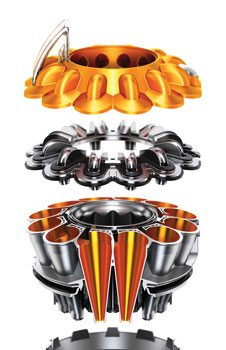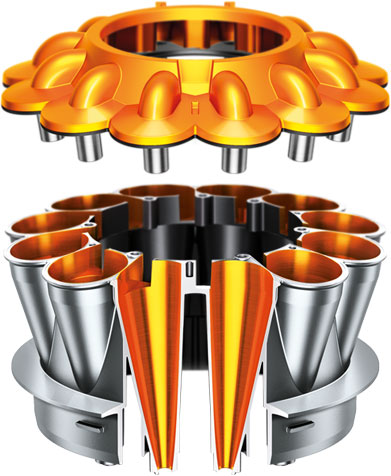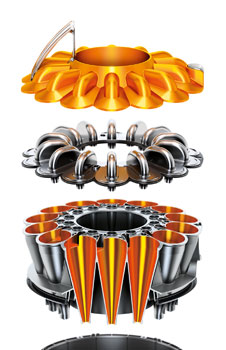Have you ever wondered how vacuum cleaners are able to clean so efficiently? Well, let me tell you about Dyson’s Radial Root Cyclone technology. It’s pretty fascinating!
So, here’s the deal. Dyson’s Radial Root Cyclone technology is a game-changer when it comes to vacuuming. Traditional vacuum cleaners rely on a bag or filter to trap dust and dirt, which can easily get clogged and decrease suction power. But, Dyson’s technology is different. It uses a series of cyclones to create a powerful centrifugal force that spins the air at high speeds, trapping even the tiniest particles of dirt and flinging them into the collection bin. This means that you won’t have to worry about losing suction power or constantly cleaning or replacing filters. It’s all about efficiency, my friend.
I can go on and on about the benefits of Dyson’s Radial Root Cyclone technology, but I don’t want to give away all the juicy details. If you want to learn more about how this revolutionary vacuuming technology works and why it’s a game-changer in the cleaning world, be sure to check out the rest of the article. Trust me, you won’t be disappointed!
1. What is Dyson’s Radial Root Cyclone Technology?
Dyson’s Radial Root Cyclone Technology is a revolutionary vacuum cleaning technology developed by the Dyson company. It is designed to provide superior suction power and effectively remove microscopic particles from surfaces. Unlike traditional vacuum cleaners, which rely on bags or filters to capture dust and debris, Dyson’s Radial Root Cyclone Technology uses a cyclonic airflow system to separate dirt and dust from the air.
1.1 How does it differ from traditional vacuum cleaners?
Traditional vacuum cleaners typically use bags or filters to trap dirt and dust. Over time, these bags or filters can become clogged, leading to a decline in suction power and a decrease in overall cleaning efficiency. Dyson’s Radial Root Cyclone Technology eliminates the need for bags or filters, resulting in consistent suction power and improved cleaning performance.
1.2 The concept behind the technology
The concept behind Dyson’s Radial Root Cyclone Technology is to create a cyclonic airflow system that maximizes suction power and effectively captures dirt and dust. The technology utilizes multiple cyclones arranged in a radial pattern, which creates a high-speed airflow that separates particles from the air. The separated particles are then collected and filtered, leaving behind clean and debris-free surfaces.
2. Key Components of Dyson’s Radial Root Cyclone Technology
2.1 Multiple cyclone technology
Dyson’s Radial Root Cyclone Technology uses multiple cyclones to create a powerful airflow. The cyclones are arranged in a radial pattern, which allows for efficient separation of dirt and dust from the air. Each cyclone generates a strong centrifugal force that forces particles to the outer edges of the cyclone, where they are then collected and removed.
2.2 Radial arrangement of cyclones
The radial arrangement of the cyclones in Dyson’s Radial Root Cyclone Technology ensures that the maximum amount of air is subjected to the cyclonic airflow. This arrangement increases the efficiency of the system and enhances the overall suction power of the vacuum cleaner. The continuous airflow created by the cyclones ensures that no dirt or dust particles are left behind.
2.3 Root Cyclone technology
Root Cyclone technology is another key component of Dyson’s Radial Root Cyclone Technology. This technology refers to the unique design of the cyclones, which channel the airflow in a way that prevents loss of suction power. By eliminating the need for bags or filters, Root Cyclone technology ensures that the vacuum cleaner maintains its suction power over time.
3. Benefits of Dyson’s Radial Root Cyclone Technology
3.1 Superior suction power
One of the main benefits of Dyson’s Radial Root Cyclone Technology is its superior suction power. The cyclonic airflow system, coupled with the multiple cyclone design, creates a powerful vacuum effect that effectively removes dirt and dust from surfaces. This results in a deeper and more thorough cleaning compared to traditional vacuum cleaners.
3.2 Effective removal of microscopic particles
Dyson’s Radial Root Cyclone Technology is highly effective in removing microscopic particles from the air. These particles can include allergens, bacteria, and other harmful substances that can impact air quality. The powerful cyclonic airflow system captures these particles and traps them in the vacuum cleaner, providing a cleaner living environment for users.
3.3 Maintenance and efficiency advantages
Another advantage of Dyson’s Radial Root Cyclone Technology is its maintenance and efficiency benefits. Since the technology does not rely on bags or filters, there is no need for regular replacements or cleanings. This not only saves time and money but also ensures that the vacuum cleaner maintains its performance over the long term. Additionally, the absence of bags or filters means that there is no risk of loss of suction power as the vacuum cleaner fills up.
4. How Dyson’s Radial Root Cyclone Technology Works
Dyson’s Radial Root Cyclone Technology works in four main steps to provide efficient and thorough cleaning.
4.1 Step 1: Intake of air and separation of larger debris
When the vacuum cleaner is turned on, air is drawn in through the intake nozzle. As the air enters the vacuum cleaner, it passes through a pre-motor filter that prevents larger debris from entering the system. The larger debris is separated and collected in a separate chamber for easy disposal.
4.2 Step 2: Creation of high-speed cyclonic airflow
Once the larger debris is separated, the air enters the main cyclonic chamber, where the magic of Radial Root Cyclone Technology happens. The multiple cyclones in the chamber create a high-speed cyclonic airflow. This airflow is crucial for the efficient separation of smaller particles from the air.
4.3 Step 3: Further separation of smaller particles
As the high-speed cyclonic airflow continues, smaller particles are forced to the outer edges of the cyclones due to the centrifugal force generated by the cyclones. This separation process ensures that only clean air continues through the cyclonic system, while the dirt and dust particles are collected in a separate container.
4.4 Step 4: Collection and filtration of remaining dust
The collected dirt and dust particles are filtered through a post-motor filter before being stored in a dust container. This filtration process traps any remaining particles and ensures that only clean air is released back into the environment. The dust container can be easily emptied and cleaned, further enhancing the maintenance advantages of Dyson’s Radial Root Cyclone Technology.
5. Performance Comparison with Traditional Vacuum Cleaners
5.1 More efficient cleaning
In comparison to traditional vacuum cleaners, Dyson’s Radial Root Cyclone Technology provides more efficient cleaning. The cyclonic airflow system and the multiple cyclones create a powerful suction that effectively removes dirt and dust from surfaces. This results in a deeper and more thorough cleaning experience, even in hard-to-reach areas.
5.2 Retention of suction power over time
Traditional vacuum cleaners often suffer from a decline in suction power as the bags or filters become filled with dirt and debris. Dyson’s Radial Root Cyclone Technology eliminates this issue by removing the need for bags or filters. The continuous cyclonic airflow and the Root Cyclone technology ensure that the vacuum cleaner maintains its suction power over time, providing consistent cleaning performance.
5.3 Improvements in air quality
Due to its efficient filtration system, Dyson’s Radial Root Cyclone Technology significantly improves air quality. The technology captures and removes microscopic particles, including allergens and bacteria, from the air. This is especially beneficial for individuals with allergies or respiratory conditions, as it helps create a cleaner and healthier living environment.
6. Applications of Dyson’s Radial Root Cyclone Technology
6.1 Household vacuum cleaners
Dyson’s Radial Root Cyclone Technology is primarily used in household vacuum cleaners. Its superior suction power and efficient cleaning capabilities make it a popular choice among homeowners. The technology’s ability to remove microscopic particles also contributes to a healthier living environment.
6.2 Industrial cleaning equipment
The powerful suction power and effective particle removal of Dyson’s Radial Root Cyclone Technology make it suitable for industrial cleaning equipment as well. Industrial vacuum cleaners equipped with this technology can efficiently clean large areas, removing dirt, dust, and debris effectively.
6.3 Automotive vacuum systems
Dyson’s Radial Root Cyclone Technology can also be found in automotive vacuum systems. The technology’s ability to remove microscopic particles and its strong suction power make it ideal for cleaning car interiors. It ensures that dirt, dust, and other particles are effectively removed, leaving the interior clean and fresh.
7. Limitations and Potential Drawbacks
7.1 Higher initial cost
One potential drawback of Dyson’s Radial Root Cyclone Technology is its higher initial cost compared to traditional vacuum cleaners. The advanced technology and innovative design of Dyson vacuum cleaners contribute to their higher price range. However, many users find that the long-term benefits and performance justify the initial investment.
7.2 Noise levels
Some users may find that Dyson vacuum cleaners equipped with Radial Root Cyclone Technology produce higher noise levels compared to traditional vacuum cleaners. The powerful airflow and the suction mechanism can generate more noise during operation. However, advancements in technology have led to quieter models in recent years.
7.3 Power consumption
Dyson vacuum cleaners are known for their powerful suction, which may result in higher power consumption compared to traditional vacuum cleaners. The technology’s efficiency in cleaning may come at the cost of increased energy usage. However, Dyson continues to work on improving energy efficiency in their vacuum cleaner models.
8. Evolution and Innovations in Dyson’s Radial Root Cyclone Technology
8.1 Evolution of the technology
Over the years, Dyson’s Radial Root Cyclone Technology has undergone continuous evolution and improvements. The company has invested in research and development to enhance the performance and efficiency of the technology. Advances in engineering and materials have led to more compact and powerful vacuum cleaners.
8.2 Recent advancements and patents
Dyson holds several patents related to Radial Root Cyclone Technology, protecting its innovations and discoveries. Recent advancements focus on improving filtration efficiency, reducing noise levels, and enhancing energy efficiency. Dyson’s commitment to innovation ensures that its Radial Root Cyclone Technology remains at the forefront of the vacuum cleaning industry.
8.3 Future possibilities
The future of Dyson’s Radial Root Cyclone Technology holds exciting possibilities. As technology continues to advance, it is likely that Dyson will further refine and improve its innovative vacuum cleaning technology. Potential areas of development may include improved filtration systems, enhanced energy efficiency, and advanced automation features.
9. Other Filtering Technologies in Vacuum Cleaners
9.1 Bagged vacuum cleaners
Bagged vacuum cleaners are a traditional alternative to Dyson’s Radial Root Cyclone Technology. These vacuum cleaners use disposable bags to collect dirt and dust. While bagged vacuum cleaners are effective in trapping larger debris, they may suffer from a decline in suction power as the bags become filled.
9.2 Cyclonic separation without Radial Root Cyclone technology
Some vacuum cleaners utilize cyclonic separation without the use of Dyson’s Radial Root Cyclone Technology. These vacuum cleaners create a cyclonic airflow that separates dirt and dust from the air. However, the lack of the radial arrangement of cyclones and the Root Cyclone technology may result in a less efficient cleaning experience.
10. Conclusion
10.1 Summary of Dyson’s Radial Root Cyclone Technology
Dyson’s Radial Root Cyclone Technology is a groundbreaking innovation in the vacuum cleaning industry. The technology’s multiple cyclones, radial arrangement, and root cyclone design create a powerful suction that effectively removes dirt, dust, and microscopic particles from surfaces. It offers superior cleaning performance, improved air quality, and maintenance advantages compared to traditional vacuum cleaners.
10.2 Impact on the vacuum cleaning industry
The introduction of Dyson’s Radial Root Cyclone Technology has had a significant impact on the vacuum cleaning industry. The technology has set a new standard for cleaning efficiency and performance. It has also spurred competition and innovation in the industry, with other manufacturers developing their own cyclonic airflow systems.
10.3 Continued benefits and future prospects
Dyson’s Radial Root Cyclone Technology continues to provide users with numerous benefits, including superior suction power, effective particle removal, and maintenance advantages. As technology advances, there is great potential for further improvements and innovations in the field. The future of Dyson’s Radial Root Cyclone Technology looks promising, promising continued benefits and enhanced cleaning experiences for users.





